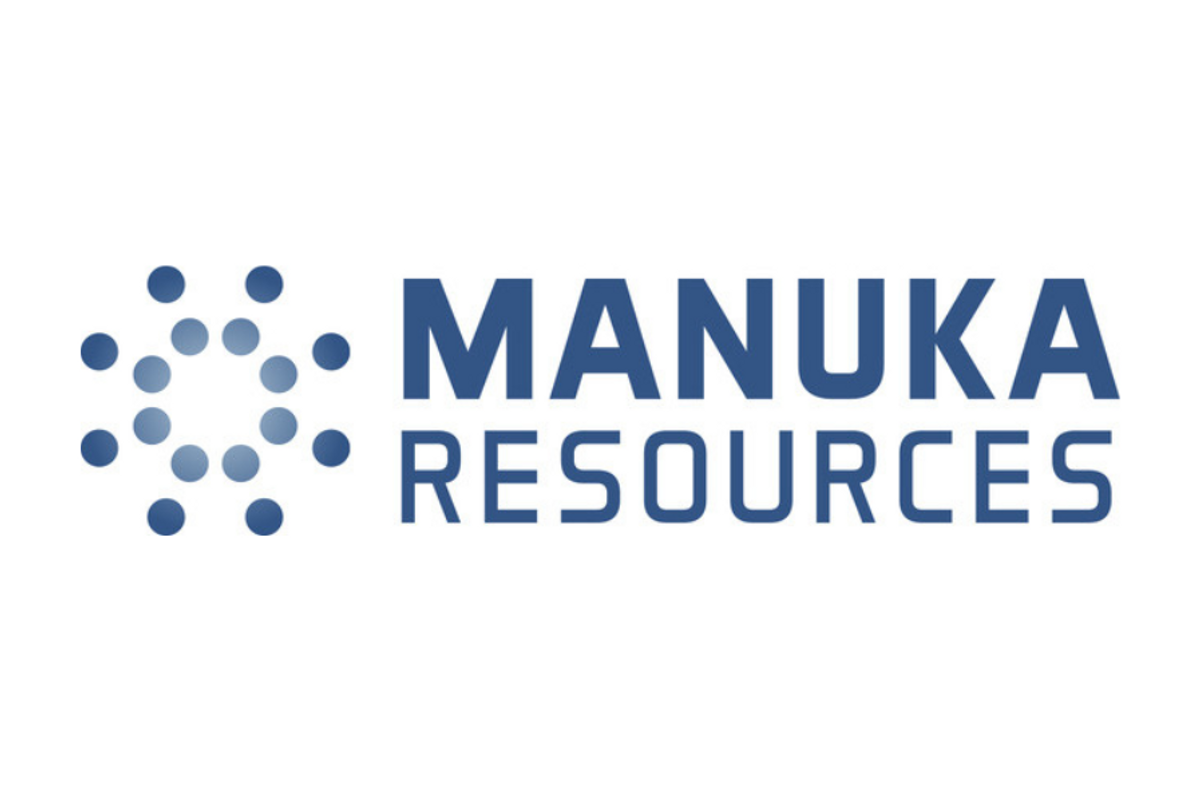

Manuka Resources Limited (“Manuka” or the “Company”) is pleased to provide the following report on its activities during the quarter ending 30 September 2024.
Highlights
During the Quarter
Post Quarter End
Dennis Karp, Manuka’s Executive Chairman, commented:
The Company continues to focus on the installation of a plant at its 100% owned Mt Boppy gold project and bringing the project into production. To date plant feed for processing has been trucked to our Wonawinta plant, which is a little over 150km away. Haulage savings (currently it costs $30/t to truck from Mt Boppy to Wonawinta) and general cost benefits arising from on-site processing, makes the economic justification for this decision clear cut.
Our recently released Maiden Silver Ore Reserve for our 100% owned Wonawinta silver project essentially provides additional precious metals optionality to the Company. Furthermore, it opens up the potential of adding a second revenue stream during 2025, further increasing our exposure to precious metals. Manuka is clear in its plans on initially bringing the Mt Boppy gold project back into production and only once steady state production is achieved, will the Company then continue with the restart of the Wonawinta silver project (subject to updated commercial modelling and silver price sentiment).
Manuka Resources is the holder of granted mining leases on three separate projects – our two Cobar Basin precious metals projects as well as our New Zealand domiciled VTM project. This is quite unusual for a company of our size and presents us with an enormous opportunity. We have a clear vision focused on achieving profitable gold and silver production from what will be two separate plants, while reducing our external debt obligations and simultaneously laying the platform for fully funded exploration and resource expansion. We also look forward to the NZ government passing the fast-track consenting approvals legislation by the end of the year with great anticipation and optimism. Our Taranaki VTM Project has been selected as a listed mining project of national significance to be considered for approval under the legislation when passed. The ongoing public statements from the National-led coalition government are very positive towards finally clearing the consenting pathway which to date has restricted our 100% owned world class vanadium rich iron sands project from getting into production.”
Click here for the full ASX Release
This article includes content from Manuka Resources Limited, licensed for the purpose of publishing on Investing News Australia. This article does not constitute financial product advice. It is your responsibility to perform proper due diligence before acting upon any information provided here. Please refer to our full disclaimer here.

Manuka Resources’ unique value proposition is focused on its three fully licenced projects, which include two precious metals assets in one of Australia’s most prolific regions for base and precious metals, and a company-making iron sands (vanadium and titanium co-products) project in New Zealand’s exclusive economic zone (EEZ) off the Taranaki bight. Manuka Resources is well-placed to deliver significant shareholder value, driven by a phased strategy that includes a clear pathway to near-term precious metals production.
Manuka Resources (ASX:MKR) is focused on bringing its precious metals assets in the Cobar Basin into production, as well as progressing its New Zealand domiciled Taranaki VTM iron sands project.
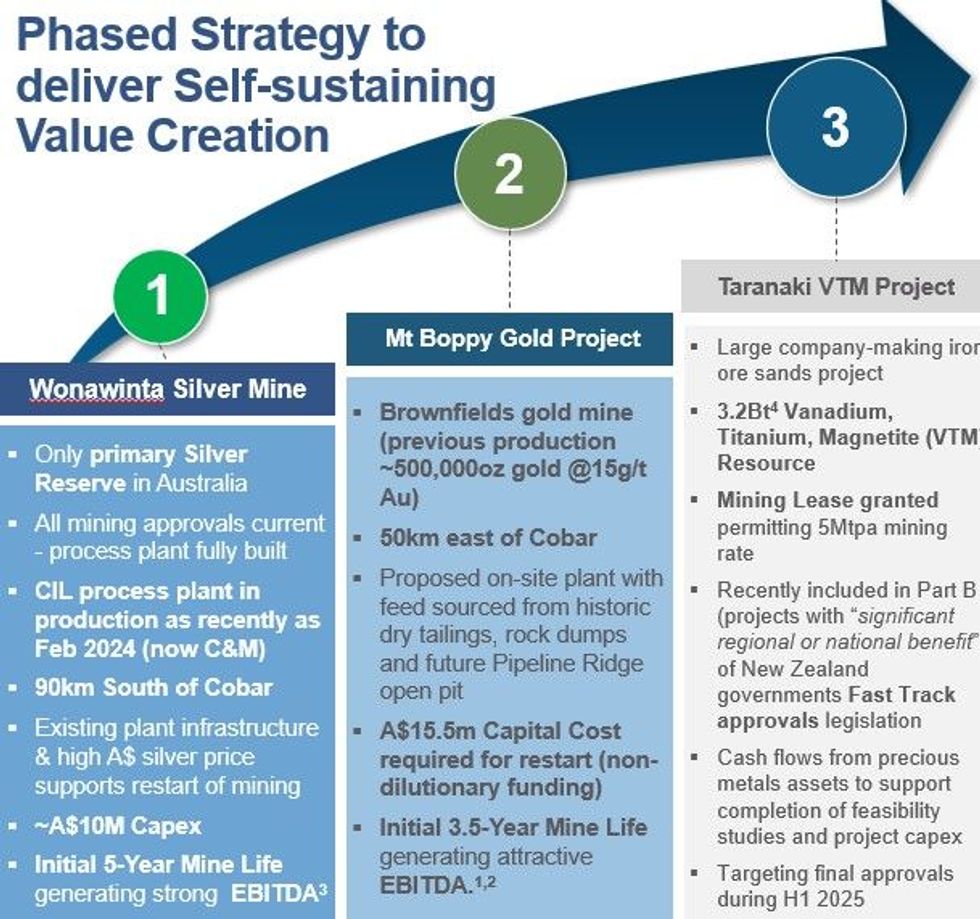
The company previously revealed a phased strategy focused on delivering maximum value to its shareholders. The first phase focused on bringing back the Mt Boppy gold mine into production and it released an optimised production plan for the mine restart. At the time, the company believed silver production would follow gold but noted it was flexible in this regard. In any event and simultaneous to this, will be the ongoing development of the Taranaki vanadium titano-magnetite (VTM) project.
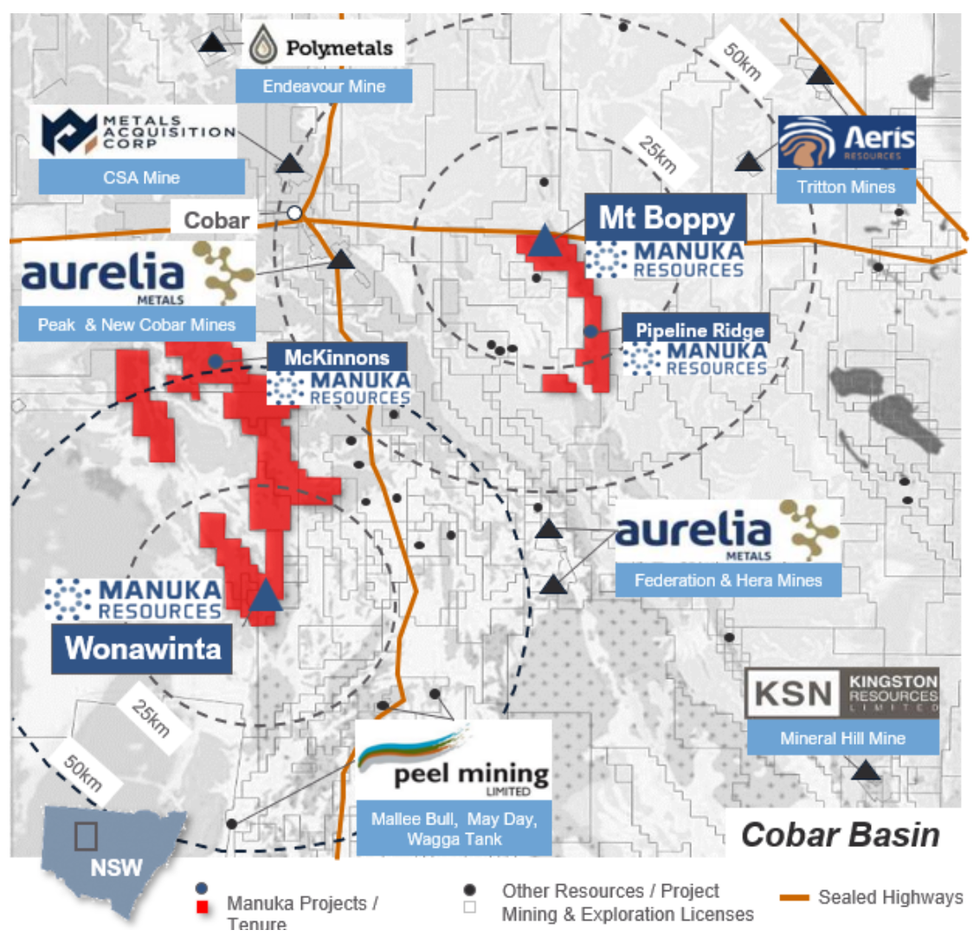
The Cobar Basin located in the central-west of New South Wales, is one of the richest mining provinces in Australia, home to some of Australia’s largest mining companies and explorers.
The Mt Boppy gold mine was historically one of the richest in NSW, Australia and produced ~500,000 oz gold at an average grade of 15 grams per ton (g/t) gold. Accordingly, the company is very excited about its exploration potential.
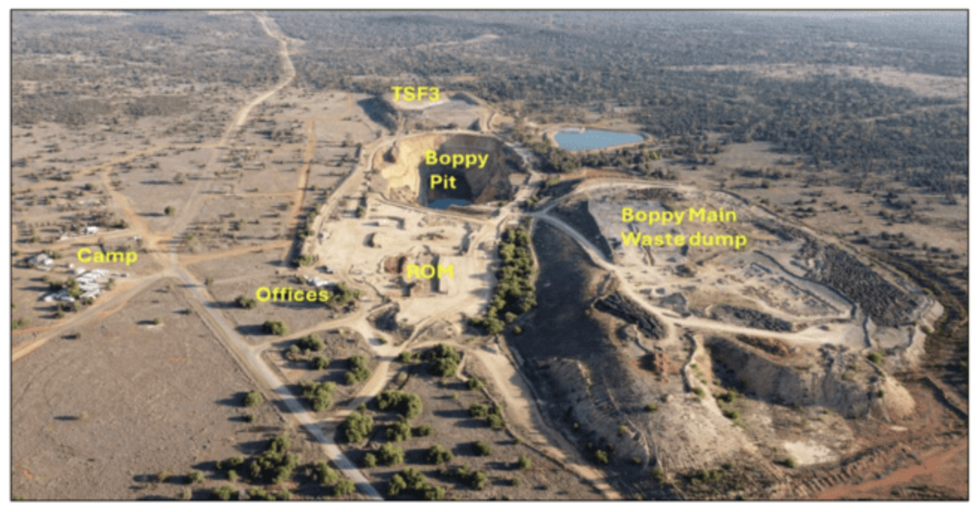
Drone image looking South showing the main components of the Rock Dump and tailing resources in relation to the Mt. Boppy open pit.
The initial five-year mine plan is largely focused on the screening and processing of gold-bearing waste material above ground on the Mt Boppy mine site. The company had been processing these wastes from June 2023 to December 2023 at its Wonawinta plant and now will look to optimize the process.
The Wonawinta silver project will be the largest primary silver producer in Australia and expected to be back in silver production within 12 months. Manuka has released a maiden ore reserve (under its ownership) of 4.8Mt1 at 53.8g/t silver containing 8.4Moz of silver comprising proven ore reserves of 0.8Mt at 50.8g/t silver; and probable ore reserves of 4.1Mt at 54.3g/t silver. Ore Reserve is based solely on shallow (<40m deep) oxide material.

The Wonawinta 100tph Ball Mill
The gold and silver market appears to be in an upward trend, with prices for both precious metals hitting their all-time highs recently, in Australian dollar terms for silver, which bodes very positively for MKR.

The Mt Boppy gold project comprises three mining leases, four gold leases and one exploration license, spanning an area of more than 210 sq km in the prolific Cobar Basin in New South Wales, Australia. The project was acquired by Manuka in 2019 and has a current mineral resource of 4.3 Mt at 1.19 g/t gold. This includes a combination of oxidized and transitional/fresh mineralization in the ground, as well as mineralized rock dumps and tailings.
Historically, Manuka Resources has processed its stockpiles and gold mineralized waste products through its Wonawinta processing plant. However, inefficiencies associated with trucking and processing ore at the distant Wonawinta plant has led the company to revise its strategy. It is now looking to construct a processing plant at Mt Boppy so that ore from the mine can be processed on-site. Mt Boppy has excellent infrastructure including a 48-person mine camp and is fully permitted for the proposed processing plant and on-site production.

The updated mineral resource comprises 4.28 Mt at 1.19 g/t gold for 163 koz of contained gold, of which 82 percent is in the measured and indicated categories.
An on-site plant will offer significant cost savings and improve the project economics.
Manuka Resources anticipates Mt Boppy to deliver total EBITDA of >AU$90 million and cash flow of >AU$80 million over a five-year mine life.

The Wonawinta project is fully permitted with all the necessary infrastructure, including an 850,000 to 1 million tpa processing plant. The plant has been used for processing ore from Mt Boppy. The Wonawinta silver mine is currently under care and maintenance. The company is considering the possibility of resuming operations at Wonawinta, leveraging the improved silver price environment. Manuka has released a maiden ore reserve (under its ownership):
The maiden silver ore reserve and the preparation of an implementation plan for Wonawinta support the potential restart of silver mining and processing operations in the near
future. The company is reviewing its silver restart plans in light of the current price increases and expects to announce a decision before the end of May 2025.

The Taranaki VTM project is located within New Zealand's exclusive economic zone, approximately 22 to 36 kilometres offshore, outside the 12 nautical mile boundary from the coastline. The project boasts a JORC resource of 3.2 billion tons at 10.17 percent iron oxide, 1.03 percent titanium dioxide and 0.05 percent vanadium oxide. It holds a mining license allowing initial extraction of 50 million tons annually, resulting in 5 million tons of VTM concentrate per year for 20 years (concentrate grade of 56 to 57 percent iron, 8.5 percent titanium dioxide and 0.5 percent vanadium pentoxide). At this extraction rate, the JORC resource provides approximately 60 years of potential mining inventory.
The project was included in the New Zealand government's Schedule 2 of the Fast Track Approvals Act 2024. The next step for Manuka was to complete pre-feasibility study (“PFS”) on the project. This was released to the market on 26 March 2025 and presents an extremely robust economic outlook for the project as can be seen below.

Dennis Karp is a former commodities trader with nearly four decades of corporate experience. He started his career in 1983 and worked in HSBC until 1997 before moving to Tennant, one of Australia’s largest physical commodities trading companies with operations in Asia and Europe. He was a principal shareholder of Tennant Metals until 2010 and a managing director until December 2014. He founded ResCap in December 2014. Since then, he has participated in diverse resource projects and investment opportunities across base metals and bulk commodities. He holds a Bachelor of Commerce from the University of Cape Town.
Alan Eggers has over 40 years of experience in the mining sector. He is a geologist and was the founder of Summit Resources, which became an ASX top 200 company and was acquired by Paladin Energy in 2007 for AU$1.2 billion. Throughout his career, he has held director positions at numerous companies. He holds a Bachelor of Science, Honours, and Master of Science degrees from Victoria University of Wellington. He is recognized as a fellow of the Society of Economic Geologists and holds memberships in AusIMM and the Australian Institute of Geoscientists.
John Seton is a lawyer with extensive experience in the mineral resources sector. He has served as director in several ASX and NZX listed companies. He holds a Bachelor of Laws from Victoria University, Wellington, and a Master of Law (Honours) from the University of Auckland and is a chartered fellow of the New Zealand Institute of Directors.
Haydn Lynch has over 25 years of experience in M&A, capital markets and private equity. He has been involved in executing several domestic and cross-border transactions in various sectors including metals and mining, and industrials. He has held leadership roles in global investment banks, including Bankers Trust Australia, Investec Bank, RBC Capital Markets and Southern Cross Equities. He has undergraduate degrees in mechanical engineering and economics from the University of Queensland and a Master in Commerce from the University of New South Wales.
Dieter Engelhardt has over 30 years of experience in the mining industry including roles as senior metallurgist at Telfer Gold Mine and Northparkes Mines, resident manager at McKinnons Gold Mine, and manager of ore processing at CSA Mine. Engelhardt was employed by Newcrest Mining (now Newmont) in various roles, including as manager of ore processing and principal metallurgist.
Phil Bentley has over 40 years of experience in the mining industry across New Zealand, South Africa, and Australia, holding senior geological roles as well as senior management and director positions. He has worked as a chief geologist at Randgold Resources and Randgold & Exploration, Global Head of Exploration at Trafigura Mining Services, and Principal Geologist Africa at CSA Global South Africa. He is a Qualified person under NI 43-101 (Canada) and JORC (Australia) and is a Fellow of the South African Geological Society. He holds a Bachelor of Science (Honours) in Geology at Victoria University of Wellington. He also has a Masters of Science in Economic Geology at Victoria University of Wellington and a Master’s of Science in Mineral Exploration from Rhodes University, Grahamstown South Africa.
Near-term production from both its silver and gold projects located in the Cobar Basin, Central West, New South Wales
Quimbaya Gold’s strategic focus on Colombia offers a compelling opportunity for gold exploration in a prolific, yet underexplored region supported by a favorable permitting environment. The upside potential is worthy of examination by any savvy investor.
Quimbaya Gold (CSE:QIM) is a junior gold exploration company focused on its high-grade gold projects in Colombia. The company’s portfolio spans 59,057 hectares across three highly prospective regions in the Antioquia mining district. This region is responsible for approximately 50 percent of Colombia’s total gold production, equivalent to around 1 million ounces (Moz) annually.
Positioned right next to Aris Mining’s (TSX:ARIS) Segovia mine, Quimbaya leverages its proximity to established infrastructure and gold-rich geological formations. With Colombia being one of the most underexplored yet top mining jurisdictions in South America, Quimbaya’s projects are uniquely poised for significant discoveries.
Quimbaya’s projects benefit from Colombia’s favorable permitting environment, enabling faster transitions from discovery to production, compared to its global peers. Quimbaya’s strategy focuses on value creation through new discoveries and monetizing them via strategic transactions, including joint ventures and operational contracts.
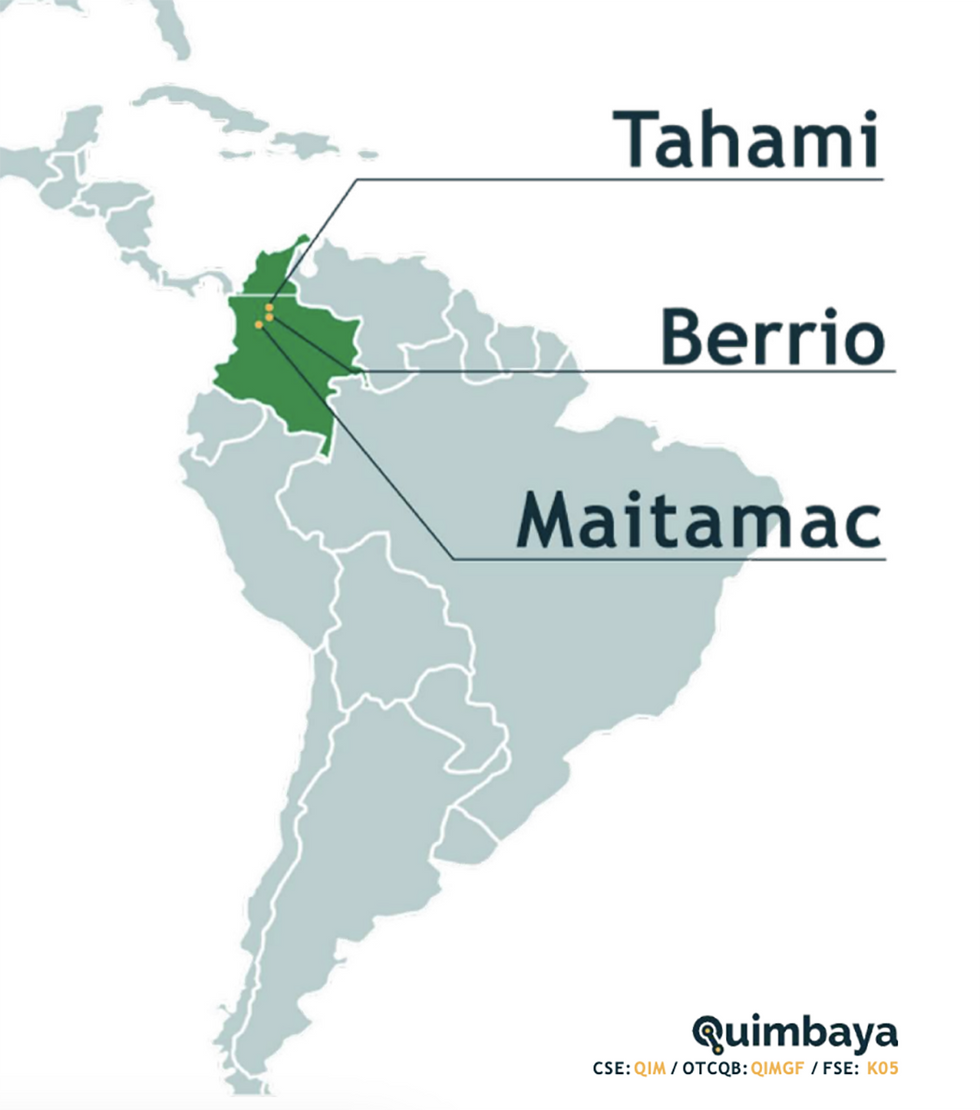
Quimbaya has established a significant partnership with Independence Drilling, Colombia’s largest drilling company with over 40 years of experience. The agreement secures 100,000 meters of drilling over five years, with Independence Drilling accepting part of its payment in Quimbaya shares. This innovative structure demonstrates strong confidence in Quimbaya’s projects, ensuring cost-effective and efficient drilling operations.
The company’s management team brings extensive and deep expertise in exploration in Colombia, corporate finance and project development. Quimbaya trades on multiple exchanges: CSE (QIM), OTCQB (QIMGF), and FSE (K05).
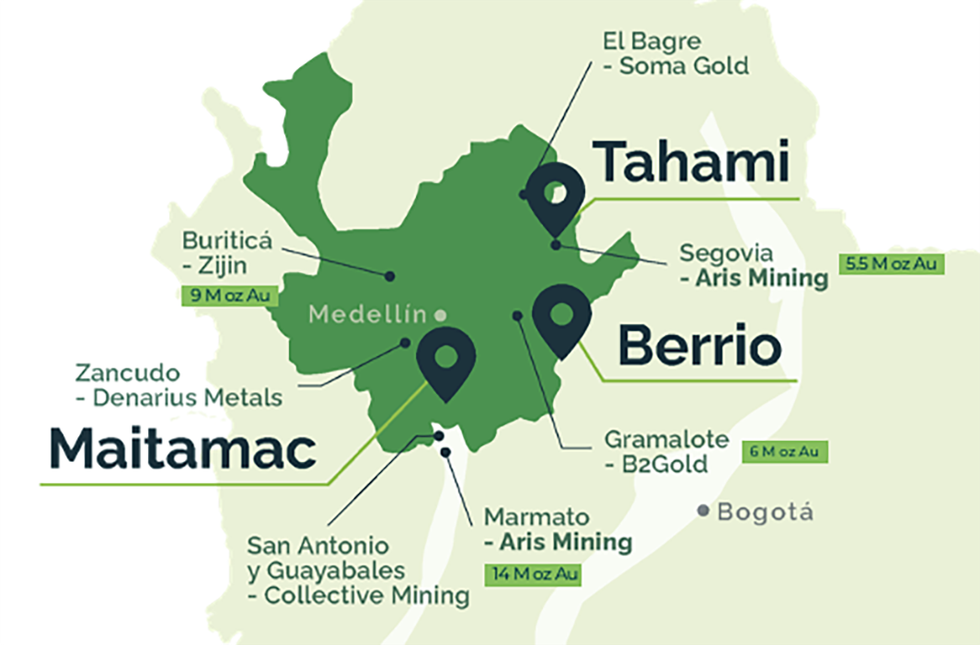
The Tahami project is located in Segovia, Antioquia, adjacent to Aris Mining’s Segovia mine, one of the highest-grade gold mines in the world. Spanning 17,087 hectares, Tahami’s geology features mesothermal veins with multiple mineralization events underlain by Precambrian metamorphic rocks consolidated within the San Lucas Gneiss unit.
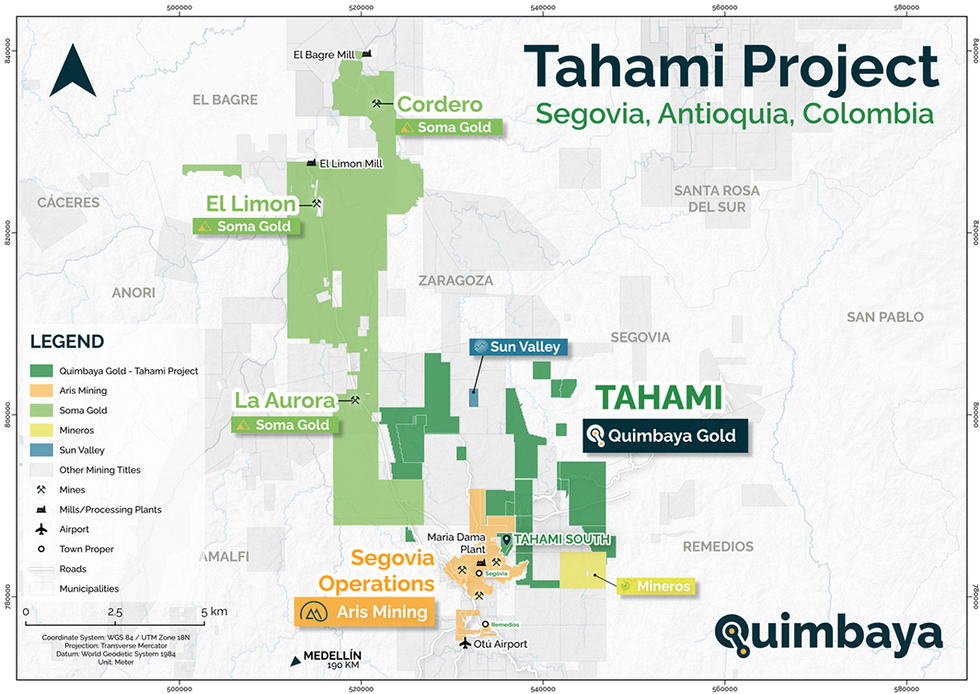
Several vein systems from Aris Mining’s Segovia project, including the Sandra K and El Silencio veins, extend towards Quimbaya’s tenements. Both the Sandra K and El Silencio veins align with structural orientations of known high-grade deposits. The project also boasts more than 25 historical artisanal mines, underscoring its prospectively.
Quimbaya’s exploration plan for Tahami involves leveraging advanced geochemical and geophysical surveys to generate drill targets. These efforts will be complemented by modern 3D geological modelling and an initial drilling campaign to test high-grade zones. The integration of historical data and cutting-edge technology positions Tahami as a prime asset for discovery. The initial drilling campaign is anticipated to commence by late Q2 of 2025 and will prioritize the high-grade targets identified in preliminary exploration work.
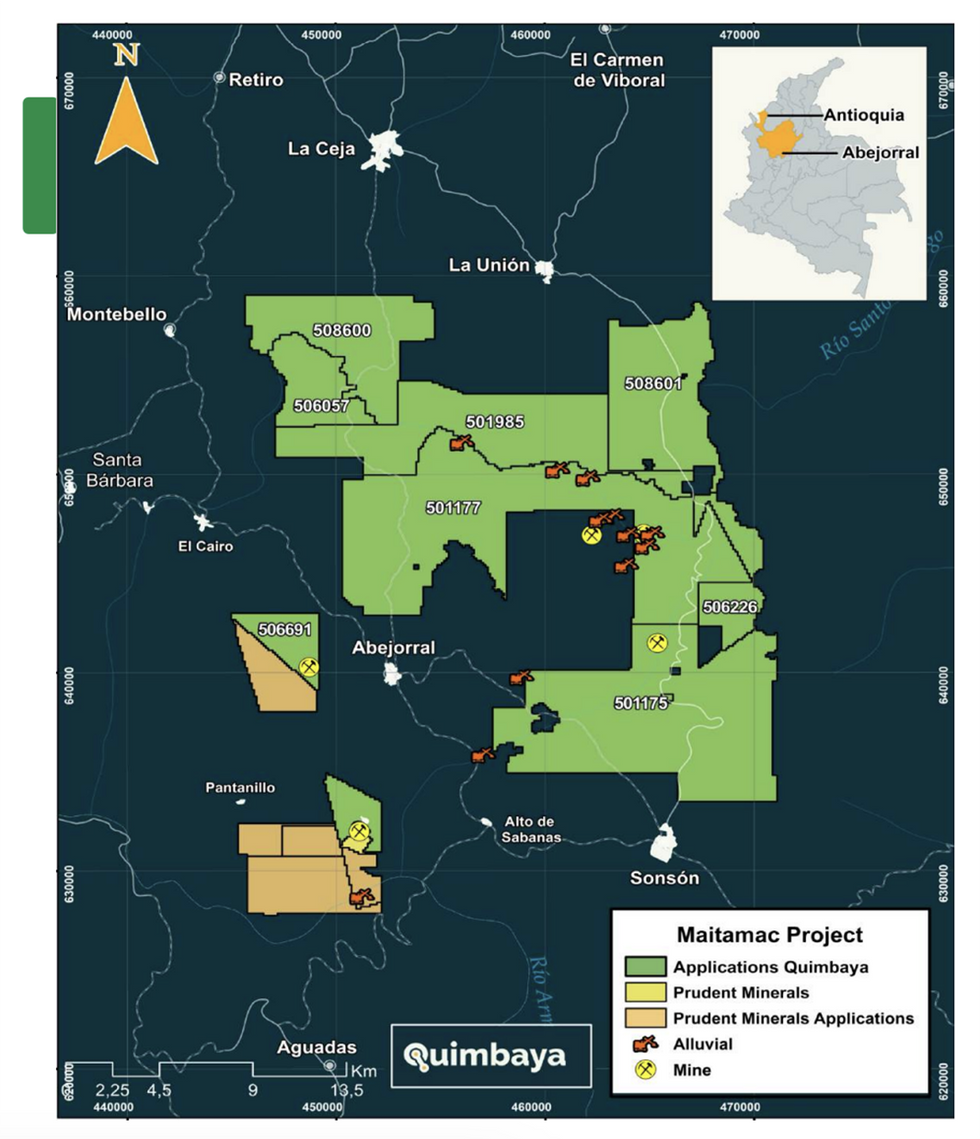
Located in Abejorral, Antioquia, 80 kilometers south of Medellín, the Maitamac project spans 33,223 hectares and offers excellent road access. This emerging gold metallogenic district features mesothermal veins and potential porphyry gold-copper systems.
Initial surface rock samples have reported gold grades of up to 3.2 g/t, with stream sediments revealing over 1 g/t gold. Identified as a promising district by the Colombian Geological Services, Maitamac is positioned alongside the past producing ABE project and structural corridor which has produced mined shoots averaging 26 g/t gold.
Alexandre Boivin is an entrepreneur with more than 10 years of experience in corporate finance and Colombian mining. Through his extensive experience in the mining industry, corporate finance, capital markets and business development, Boivin has been instrumental in managing and funding early-stage companies through a network of partners and investors immersed in the capital markets. Under his leadership, Quimbaya Gold has secured significant investments to advance its exploration projects. His commitment to the company's growth is further demonstrated by his substantial shareholding in Quimbaya Gold.
Olivier Berthiaume is an accountant with over 12 years of experience working with early-stage companies in the Canadian markets. He holds a Bachelor of Business Administration from HEC Montreal and specializes in private-to-public market transactions, compliance, corporate governance, and corporate growth strategies. Berthiaume has held various director and officer positions in junior mining companies.
Sebastian Wahl brings over 15 years of experience in the mining industry, with a strong focus on precious metals trading, capital markets, and corporate development. Wahl has played a pivotal role in shaping Quimbaya Gold’s strategic direction and elevating its external positioning during a critical growth phase.
Ricardo Sierra is a professional economic Geologist with over 18 years of exploration experience in Colombia-Chile-Cuba-Brazil in orogenic, mesothermal, porphyry type deposits, epithermal systems, and stratabound. Sierra started his career with ANGLO AMERICAN as an exploration geologist in greenfield and brownfield exploration, supervising diamond drilling on their Colombian properties. His knowledge in vein systems, critical in understanding mineralization processes, was honed while exploration superintendent with Continental Gold (now Zijin Mining Group) on their Buritica (Antioquia) deposit, also in their regional exploration (Choco, Nariño, Cauca, Antioquia). Sierra graduated in 2007 as a geologist from Universidad de Caldas (Colombia). He is a member of the Australian Institute of Mining and Metallurgy (MAusIMM) and is a qualified person (QP) as defined by National Instrument 43-101, also he is a Competent Person (CP) of Comision Colombiana de Recursos y Reservas Mineras (CCRR).
Stewart Redwood is a distinguished geological consultant with more than 40 years of experience in mineral exploration and economic geology, specializing in epithermal, porphyry and skarn deposits, particularly in Latin America and the Caribbean. His notable achievements include significant discoveries, including the San Cristobal silver-zinc deposit in Bolivia, the Romero gold-copper deposit in the Dominican Republic, and the Antamina copper-zinc project in Peru, recognized as the world's largest copper skarn deposit. Throughout his career, Redwood has held key positions in prominent mining and exploration companies, including as chief geologist Latin America for AngloGold Ashanti, founder president and CEO of GoldQuest Mining, and VP exploration of Colombia Goldfields (which merged with Gran Colombia Gold). He has been instrumental in the success of Gran Colombia Gold’s Marmato project (now owned by Aris Mining), currently an 8.8 Moz deposit in the construction stage.
A Colombian native, with over 28 years of experience focused in the mining district of Antioquia, currently the CEO of MINING BRAIN SAS, Nicolas Lopez, leads this consulting company advising on the implementation, development of sustainable mining projects all over Colombia. Prior to the establishment of his consultancy practice, Lopez spent 12 years as Colombia & Nicaragua's country manager for IAMGOLD, having devoted the previous 10 years with MINEROS SA as head of exploration & geology. Villegas played a pivotal role in major discoveries, including the first porphyry copper-gold deposit in the Colombian middle Cauca belt, known as Titiribi. a significantly rich gold-copper geological region. As a seasoned executive in gold exploration, Villegas holds a geology degree from Universidad de Caldas (Colombia), a Governance in Oil & Mining degree from Oxford University (UK) and he is a Qualified Person (QP).
Terence Ortslan is a seasoned resource executive with over 40 years of experience, having served in advisory capacities across the mining, metals, and fertilizer sectors. He provides guidance on investment and technical aspects of the industry, as well as strategic and policy advice tailored to mining companies. Additionally, Ortslan advises financial institutions on investment decisions, offers direction to international industry organizations, and consults with governments on fiscal and industrial regulations. He also supports universities in enhancing their educational standards and assists corporations with decision-making, boardroom leadership, shareholder value enhancement, and strengthening ES parameters. Ortslan holds a Bachelor of Engineering & Applied Geophysics and an MBA from McGill University.
Asara Resources (ASX:AS1,FSE:ALM) is leading the next West African gold rush from a strategic position in Guinea’s underexplored Siguiri Basin—an emerging gold district with over 30 million ounces of historical and current gold production.
Asara Resources’ flagship Kada Kold project hosts a 923,000-ounce, oxide-dominant gold resource just 35 km south of AngloGold Ashanti’s 6.2 Moz Siguiri mine. The company is systematically advancing development using the proven “string-of-pits” model that has driven success across West Africa, guided by a seasoned team behind the Kiniero Project, now a cornerstone asset for Robex (TSX:RBX).
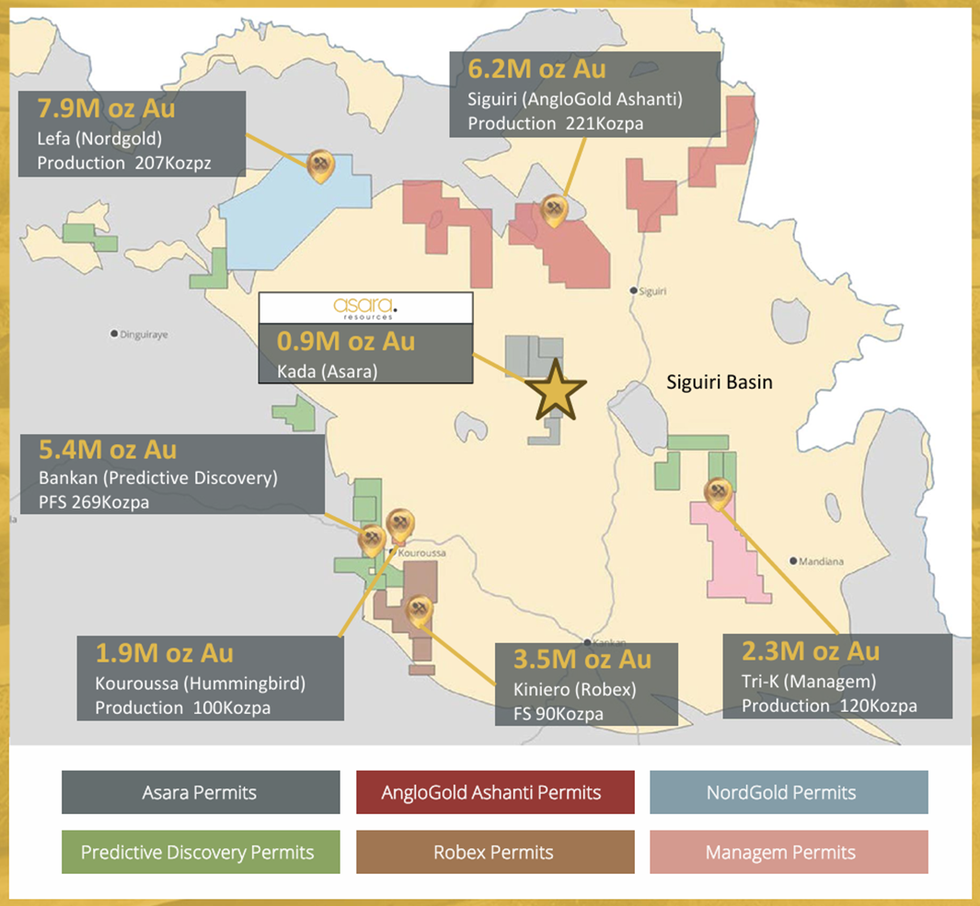
Asara’s near-term strategy focuses on three key priorities: accelerating resource growth with 33,600 metres of RC and diamond drilling planned for 2025; advancing a low-CAPEX, oxide-first development approach that capitalizes on free-dig saprolite, strong gold recoveries, and a conventional CIL flowsheet; and preserving upside exposure to copper and silver-zinc through its Loreto joint venture with Teck and the optional Paguanta asset in Chile.
This Asara Resources profile is part of a paid investor education campaign.*
Click here to connect with Asara Resources (ASX:AS1) to receive an Investor Presentation
New Age Exploration (ASX:NAE) is shaping a focused gold exploration story anchored by high-quality assets in tier-one jurisdictions across Western Australia and New Zealand. The company’s strategy is clear: target proven geological corridors and apply modern, cost-efficient exploration methods to uncover new zones of mineralization.
In Western Australia, New Age Exploration’s Wagyu Gold Project sits directly along strike from De Grey Mining’s Hemi discovery, now part of Northern Star Resources (ASX:NST). In New Zealand, its Lammerlaw and Otago Pioneer Quartz projects are positioned within the same regional structure that hosts OceanaGold’s (TSE:OGC) 5 Moz Macraes deposit and Santana Minerals’ (ASX:SMI) fast-growing Rise & Shine system.
 Wagyu gold project location map
Wagyu gold project location mapThe Wagyu Gold Project is New Age Exploration’s flagship asset, located in the highly prospective Central Pilbara region of Western Australia. Positioned between Northern Star’s 11.7 Moz Hemi deposit and the Withnell deposit within the Mallina Basin, Wagyu targets the same intrusive-style orogenic gold system. NAE holds a 136 sq km exploration licence (E47/2974) and has completed extensive early-stage work, including reinterpretation of geophysical data to identify Hemi-style intrusions and structurally hosted gold targets.
This New Age Exploration profile is part of a paid investor education campaign.*
Click here to connect with New Age Exploration (ASX:NAE) to receive an Investor Presentation
Kobo Resources Inc. (TSX.V: KRI):
This press release features multimedia. View the full release here: https://www.businesswire.com/news/home/20250708360290/en/
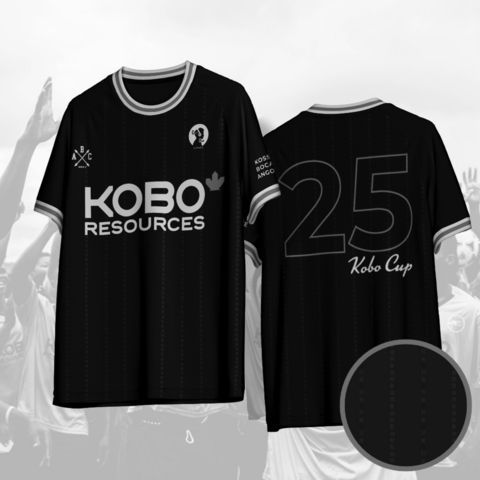
KOBO CUP SUPPORTER JERSEY
Building on the success of the inaugural Kobo Cup in 2024, Kobo Resources has proudly expanded this initiative in 2025 into a full multi-village tournament. This year also featured a dynamic art workshop where young artists from Kossou, Bocabo, and Angossé designed the official jerseys their teams will wear.
We are excited to take this celebration of local talent and meaningful community partnerships even further with the launch of the exclusive "2025 Kobo Cup Supporter Jersey" . This limited-edition jersey symbolizes more than just a game; it represents Kobo's ongoing commitment to social responsibility and direct support for the villages where they operate.
A JERSEY WITH PURPOSE
Designed with deep cultural significance, the "Supporter Jersey" proudly showcases six traditional Adinkra symbols, iconic motifs from West African heritage known for their powerful meanings and values. These symbols are thoughtfully repeated across the fabric, each representing qualities that inspire and reflect the spirit of the villages Kobo Resources supports.
Together, these symbols represent leadership, perseverance, adaptability, strength, wisdom, and community abundance. They embody the core values and spirit of the villages Kobo Resources supports, weaving a narrative of resilience, unity, and hope that investors can proudly wear as a symbol of their commitment to sustainable community development.
DIRECT IMPACT FOR VILLAGE NEEDS
All profits from the sale of the "2025 Kobo Cup Supporter Jersey" will be channeled directly into addressing urgent needs within the villages, including providing school supplies, everyday goods, and essential resources that help improve daily life. This initiative marks a direct, transparent way for investors to contribute to sustainable community development beyond traditional infrastructure projects.
KOBO'S COMMITMENT TO COMMUNITY
The Kobo Cup has evolved from a single football match into an annual multi-village tournament celebrating local talent, culture, and youth empowerment. With in-country partners like African Boyz Club and Coast to Coast Entertainment, Kobo Resources continues to foster inclusion and cultural pride while ensuring fair play and equal opportunity on the field.
"As we deepen our community engagement through the Kobo Cup and beyond, the Supporter Jersey is a unique opportunity for investors to wear their commitment to social responsibility and to help fuel meaningful change for the villages we serve," said Edward Gosselin, CEO of Kobo Resources.
How to Get Your Jersey
The limited-edition "2025 Kobo Cup Supporter Jersey" is available exclusively on the Kobo Resources website.
About Kobo Resources Inc.
Kobo Resources is a growth-focused gold exploration company with a compelling new gold discovery in Côte d'Ivoire, one of West Africa's most prolific and developing gold districts, hosting several multi-million-ounce gold mines. The Company's 100%-owned Kossou Gold Project is located approximately 20 km northwest of the capital city of Yamoussoukro and is directly adjacent to one of the region's largest gold mines with established processing facilities.
View source version on businesswire.com: https://www.businesswire.com/news/home/20250708360290/en/
For further information, please contact:
Edward Gosselin
Chief Executive Officer and Director
1-418-609-3587
ir@kobores.com
X: @KoboResources | LinkedIn: Kobo Resources Inc.
News Provided by Business Wire via QuoteMedia
The gold price continued to surge to new record highs in the second quarter of the year, reaching an all-time high of C$4,663.85 per ounce, or US$3,433.47, on June 13.
The gains were primarily fueled by safe-haven investment as Israel and the United States launched attacks on Iranian nuclear sites and Iran retaliated against targets in Israel and a US base in Qatar. Although a ceasefire was announced, tensions in the region remain high.
Additional tailwinds come from the continuing uncertainty in global financial markets, stemming from shifting US trade policy and Donald Trump's ongoing, on-again-off-again tariff plans.
There is also additional uncertainty going into the second half of the year as the US government passed its “Big Beautiful Bill” on July 3. The bill has been criticized from both sides, including the former head of the Department of Government Efficiency, Elon Musk, for increasing deficit spending and exacerbating an already ballooning debt, which some investors believe is driving the US toward a debt crisis.
What does this mean for junior gold companies? While there was delay in translating high gold prices into share price gains for gold explorers, many are now up significantly this year. Below, we profile the five TSXV gold companies that are the best performers of 2025 by year-to-date share price gains.
Data for this article was retrieved on July 3, 2025, using TradingView's stock screener, and only companies with market capitalizations greater than C$10 million are included.
Year-to-date gain: 846.34 percent
Market cap: C$122.48 million
Share price: C$1.94
Onyx Gold is an exploration company advancing its Munro-Croesus project, located near Timmins in Ontario, Canada. The company has increased the size of the land package by 200 percent between 2020 and 2025, and the project now covers an area of 109 square kilometers.
Munro-Croesus hosts the historic Croesus mine, which produced 14,859 ounces of gold between 1915 and 1936 with an average grade of 95.3 grams per metric ton (g/t). Onyx is the first company to explore the property since the mine closed.
Shares in Onyx have had significant gains in the second quarter of 2025. The momentum came as the company announced option agreements to enlarge its land package at Munro-Croesus.
The first announcement came on April 10, when it stated that it had agreed with private vendors to acquire a 21 hectare patented claim near the Argus North zone. Under the terms of the agreement, Onyx has the option to acquire a 100 percent interest in the property, which has never been drilled, in exchange for cash consideration of C$1.5 million and 3.3 million Onyx shares over a three-year period.
The second acquisition was announced on June 24, when Onyx reported that it signed a mineral property purchase and sale agreement to acquire a 100 percent interest in the Munro and Hewitt properties, both located near the existing Munro-Croesus project. The acquisition will expand the company’s land package from 95 to 109 square kilometers.
Alongside its land consolidations, Onyx has also spent the second quarter advancing exploration at the property.
Most recently, on June 26, the company reported the first drill results from its 10,000 meter spring drill program at the Argus North zone at Munro-Croesus. One highlighted assay contained 1.8 grams per metric ton (g/t) gold over 91 meters, including 4 g/t over 32 meters and 5.3 g/t over 17 meters.
The company said the results demonstrate the continuity of broad zones of high-grade gold mineralization.
Shares in Onyx reached a year-to-date high of C$2.09 on June 27.
Year-to-date gain: 500 percent
Market cap: C$217.34 million
Share price: C$0.99
Goldgroup Mining is a gold production, development and exploration company working to advance its Cerro Prieto heap-leach gold mine. The 4,335 hectare property, located in Sonora, Mexico, produces an annual average of 11,500 ounces of gold and has produced more than 120,000 ounces since its beginning in March 2013.
Goldgroup is currently working to double the capacity of the mine to more than 25,000 ounces per year. The last update on progress came in October 2024, when it announced that it had installed the primary crusher with a 2,200 metric ton per day throughput. It also said it had expanded pumping and irrigation capacity.
The most recent update on Cerro Prieto came on March 26, when Goldgroup announced high-impact exploration near the mine. The program will include 6,000 meters of diamond drilling focused on the Nuevo Esperanza and Reyna zones, which are next to the main Esperanza production zone.
The company also announced plans for an induced polarization geophysical survey and surface trenching 1 kilometer south of the mine to further investigate newly discovered mineralized zones.
In addition to activities at Cerro Prieto, the company announced on March 7 that it had entered an agreement to acquire Minera Apolo and its Pinos gold project from Candeleria Mining in exchange for settling a US$2.7 million loan facility. Goldgroup previously secured rights to the facility with Candeleria from a creditor group in a maneuver to acquire the project.
Pinos is a fully permitted gold project situated in the Zacatecas mining belt of Northern Mexico and comprises 29 concessions over 3,816 hectares. A 2018 PEA revealed an after-tax net present value of US$12 million, with a 25 percent internal rate of return at a gold price of US$1,250 per ounce.
Shares in Goldgroup reached a year-to-date high of C$1.08 on May 9.
Year-to-date gain: 400 percent
Market cap: C$19.62 million
Share price: C$0.75
Trident Resources, formerly Eros Resources, is a gold and copper exploration company focused on projects in Saskatchewan, Canada.
A three-way merger in early 2025 between Eros Resources, MAS Gold and Rockridge Resources, allowed the companies to consolidate a portfolio of assets in Saskatchewan, including the Contact Lake and Greywacke gold projects in the La Ronge gold belt as well as the Knife Lake copper project.
Before this year, Eros was focused on the Bell Mountain gold-silver project in Nevada, US, but on January 6, the company announced it had sold the property to Lincoln Gold Mining (TSXV:LMG) in exchange for up to 4.5 million common shares and a net profits interest of 7.5 percent of net returns from gold and silver produced at the project to a maximum of US$2 million.
The company announced its rebranding from Eros to Trident on April 23, with its new name chosen in part to represent the three companies joining together. In the release, the company stated that the rebrand marked the beginning of a new chapter for the company, underscoring its focus on the gold and copper markets.
On May 6, Trident announced it received drill permits for the Contact Lake project, marking the first project news following the rebrand.
Trident stated the drill program would be conducted over the summer and consist of approximately 5,000 meters, with 3,800 meters to be carried out at the Contact Lake deposit and 1,200 meters at the Preview SW deposit.
Shares in Trident reached a year-to-date high of C$0.75 on July 3.
Year-to-date gain: 333 percent
Market cap: C$15.28 million
Share price: C$0.065
Solstice Gold is an exploration company focused on advancing its flagship Strathy gold project in Ontario, which it acquired in June 2024.
The project consists of 45 claims covering an area of 45 square kilometers in the Temagami Greenstone belt. Historical documents report six gold showings in the central portion of the project areas, with documented mineralization at the Leckie prospect.
On January 15, Solstice announced results from an induced polarization survey of the property. It identified 50 new targets, with the highest priority targets being along strike on the Leckie Fault. The company stated that the results support the existence of an extensive, largely unexplored system, with potential for multiple discoveries.
Solstice said it had also been selected to receive a grant under the Ontario Junior Exploration Program from the provincial government. The grant will provide 50 percent of the exploration funding, up to a maximum of C$194,000.
Shares in Solstice gained early in the year following its January 20 announcement that Michael Gentile had increased his stake in Solstice to 16.76 percent, making him the single largest shareholder.
In its latest project update on July 2, Solstice announced it had wrapped up its spring drill program, which focused on four target areas. In total, the company completed 3,125 meters of drilling across 14 holes, and results are expected in July.
The company reported that it had entered into an agreement to acquire 17 additional claims, which would increase the project area by 50 percent. It added that targets identified from its IP program may extend along strike into these claims.
Shares in Solstice reached a year-to-date high of C$0.065 on June 27.
Year-to-date gain: 300 percent
Market cap: C$28.49 million
Share price: C$0.10
Lahontan Gold is a development and exploration company dedicated to advancing a portfolio of properties in Nevada, United States.
Its primary focus is on its flagship Santa Fe gold-silver project in Walker Lane. The property consists of 291 unpatented lode mining claims, 67 unpatented mill site claims, and 24 patented lode mining claims, covering a land package of 26.4 square kilometers.
On January 24, the company released a PEA for the project that demonstrated an after-tax net present value of US$56.5 million with an internal rate of return of 17.4 percent over a payback period of 4.24 years based on a gold price of US$2,025 per ounce.
The included MRE for the site reports an indicated resource of 1.44 million ounces of gold and 11.2 million ounces of silver from 48.39 million metric tons of ore at an average grade of 0.92 g/t gold and 7.18 g/t silver. It also hosts an inferred resource of 401,000 ounces of gold and 1.75 million ounces of silver from 16.76 million metric tons at a grade of 0.74 g/t gold and 3.25 g/t silver.
The most recent news from Lahontan was on March 18, when it provided an update on its Exploration Plan of Operation submitted to the Bureau of Land Management in November 2024. In the release, the company stated it expects the Bureau to approve the plan, allowing permitting to proceed to the National Environmental Policy Act phase. According to Lahontan, final approval is on track for late 2025.
In the meantime, Lahontan stated that it would be able to continue exploration drilling at its patented mining claims under a Notice of Intent (NOI). On May 6, the company filed a new NOI for additional drilling at the site that would target extensions in the Slab and York areas of the project, and the BLM approved it on June 9.
Additionally, the company announced on June 24 that it had started metallurgical test work at Santa Fe with the goal of substantially improving CN leach gold recoveries for transition materials compared to the 49 percent recovery in the PEA.
Shares in Lahontan reached a year-to-date high of C$0.105 on June 25.
Don’t forget to follow us @INN_Resource for real-time updates!
Securities Disclosure: I, Dean Belder, hold no direct investment interest in any company mentioned in this article.
Editorial Disclosure: Lahontan Gold is a client of the Investing News Network. This article is not paid-for content.
As it advances its portfolio of gold assets in Western Australia’s prolific Pilbara gold province and New Zealand’s Otago Schist Belt, New Age Exploration presents a compelling investor value proposition, supported by a lean, discovery-driven strategy and an experienced technical team.
New Age Exploration (ASX:NAE) is building a pure-play gold exploration story centered on high-quality assets in tier-one jurisdictions in Western Australia and New Zealand. The company’s clear strategy is to operate in geological corridors already proven by major discoveries, while applying modern, cost-effective exploration techniques to define new zones of mineralization.

In Western Australia, the company’s Wagyu gold project is directly along strike from De Grey Mining’s Hemi discovery – now owned by Northern Star Resources (ASX:NST). In New Zealand, its projects - Lammerlaw and Otago Pioneer Quartz – lie within the same regional structure that hosts OceanaGold’s (TSE:OGC) 5 Moz Macraes deposit and Santana Minerals’ (ASX:SMI) rapidly growing Rise & Shine system.
With gold prices hovering at all-time highs, NAE’s approach favours technology-led targeting, rather than brute-force drilling campaigns, by using geophysics, geochemistry and passive seismic to zero in on structurally controlled gold systems with potential for scale.
All its projects are supported by local technical teams and seasoned exploration leadership, allowing concurrent progress and capital-efficient deployment. Recent programs at Wagyu and Lammerlaw have confirmed early-stage discoveries, and both assets are advancing through their next stages of drilling and target definition.
The Wagyu gold project is New Age Exploration’s flagship asset located in the highly prospective Central Pilbara region of Western Australia. The project is strategically situated between two major gold systems – Northern Star’s Hemi Gold Deposit (11.7 Moz gold resource) and the Withnell deposit – within the Mallina Basin, which hosts a similar intrusive-style orogenic gold mineralizing system. NAE holds exploration license E47/2974, which covers 136 sq km. Since acquiring the project, NAE has conducted extensive early-stage exploration, beginning with the reinterpretation of geophysical datasets, including airborne magnetics, radiometrics and satellite imagery, to delineate potential Hemi-style intrusions and structurally hosted gold targets.

Wagyu gold project location map
The company-initiated fieldwork in April 2024, completing soil sampling, gravity surveys and passive seismic geophysical surveys to refine drill targets. These efforts culminated in an extensive aircore drilling campaign (257 holes, over 7,000 m drilled), which identified a broad, crescent-shaped gold anomaly approximately 1.5 km in strike length. Notable results included intercepts such as 5.3 grams per ton (g/t) gold over 4 m (including 15.6 g/t gold over 1 m) and 2.7 g/t gold over 2 m. Encouraged by these results, the company completed its maiden RC program in March-April 2025, drilling 3,023 m across 33 holes targeting two high-priority gravity anomalies. Assays released in May 2025 confirmed a shallow oxide gold system and evidence of underlying mineralized structures, including 1.26 g/t gold over 5 m from 31 m (WRC029), 1.32 g/t gold over 3 m from 43 m (WRC031), and 1.44 g/t gold over 2 m from 83 m (WRC009). Numerous other holes returned mineralized intervals of 0.5 to 0.8 g/t over broad zones.
Importantly, geological logging and geophysical modeling support the presence of vertical feeder structures, interpreted as potential gold-bearing intrusions and fault-hosted "pipes," similar to Hemi’s discovery model. The Wagyu system remains open in all directions, with multiple untested gravity targets and deeper feeder zones yet to be explored. A follow-up RC campaign is planned for Q3/2025, focused on extending mineralization and chasing those deeper pipe-like structures beneath the supergene blanket.

Lammerlaw permit occurs in the southern limb of a regional fold feature characterised by a change in metamorphic grade from upper greenschist (purple) to lower greenschist (green).
The Lammerlaw gold and antimony project is located in the Otago Schist Belt, a prolific gold-bearing region in the South Island of New Zealand. The project spans 265 sq km and is held under Exploration Permit EP60807. The area is renowned for its historic gold production and geological similarity to OceanaGold’s Macraes Mine, New Zealand’s largest active gold mine with more than 5 Moz in resources. NAE acquired the project through a competitive acreage release and has since completed desktop studies, field mapping and geochemical sampling, which identified multiple 2 to 4 km-long gold-antimony soil anomalies aligned with historical workings.
During 2023-2024, the company identified nine high-priority drill targets based on soil geochemistry (gold, antimony, arsenic, tungsten), historic production data and structural mapping. NAE mobilized a Phase 1 RC drill program in early 2025, designed to test structurally hosted vein systems within both brittle and ductile deformation zones. This work confirmed the presence of gold and antimony mineralization in several targets, though results are still under review. Access to some targets is subject to Department of Conservation approvals, which the company is pursuing concurrently. A Phase 2 drill campaign is planned for Q1/2026, pending access approvals and final interpretation of current results.

Overview of prospects locations within the OPQ Gold Exploration Project.
The Otago Pioneer Quartz (OPQ) project is in Central Otago within the historic Gabriel’s Gully gold district, the epicenter of the 1860s Otago gold rush. The project lies within the same regional schist belt that hosts OceanaGold’s Macraes operation. NAE acquired the OPQ tenement to secure additional exposure to high-grade shear-hosted and orogenic gold systems in the Otago region. The area is characterized by low-sulphide gold quartz veins associated with greenschist facies metamorphic rocks and late-stage brittle faulting.
While still early-stage, the company has conducted preliminary soil sampling and mapping across the tenement to delineate mineralized structures. Historical records suggest significant past production from alluvial and hard-rock sources, though modern exploration has been minimal. Given its proximity to known gold-bearing shear zones and favourable host rocks, OPQ remains a high-priority, low-cost exploration asset for future campaigns.
Going forward, NAE intends to conduct detailed geochemical and structural mapping, followed by scout drilling at known historical workings. The project remains a capital-light optionality play with future drill programs dependent on results from Lammerlaw and Wagyu.
Alan Broome is a highly respected figure in the Australian mining industry with more than 40 years of experience across mining, metals and mining technology. A metallurgist by training, Broome has served as chairman and director of numerous ASX-listed and private companies, contributing to significant exploration and development successes. His leadership brings deep strategic insight and a proven track record in guiding discovery-stage companies through to project advancement.
A capital markets executive with deep ASX and venture experience, Joshua Wellisch leads strategic and operational execution for NAE’s projects. Wellisch is also currently a director of NRG Capital, specialising in capital raisings, corporate structuring and the facilitation of ASX listings and was formerly managing director of Kairos Minerals Limited.
Appointed in 2025, Peter Thompson brings 35+ years of exploration leadership including stints at Western Mining, Anaconda Nickel, and as CEO of St Barbara. He led redevelopment of Beaconsfield Gold Mine, spearheaded the acquisition, listing and development of the Karlawinda gold deposit and was instrumental in the discovery and advancement of large volcanogenic massive sulphide deposits in Mongolia.
James Pope is a highly experienced minerals sector professional with nearly 30 years in exploration, consulting and research across a broad range of commodities including gold, PGE, diamonds, base metals, coal and coal seam gas. He currently leads Strata Geoscience, a specialised geoscience consultancy based in Christchurch, New Zealand. Throughout his career, Pope has progressed from hands-on geological mapping and drill site supervision to leading multidisciplinary teams of up to 50 professionals delivering exploration, resource assessment, engineering and environmental services.
Kerry Gordon is a seasoned minerals sector professional with nearly 25 years of experience spanning exploration, resource development and operations. He is currently a principal at Strata Geoscience, and has worked across New Zealand, Australia, Papua New Guinea, Vietnam and Mongolia on projects involving gold, critical metals (antimony, tungsten), coal, coal seam gas, and conventional petroleum. Gordon is an expert at managing exploration programs in remote and technically demanding environments, with a strong focus on field-based geological techniques, complex drilling and downhole logging operations, and logistical coordination.
